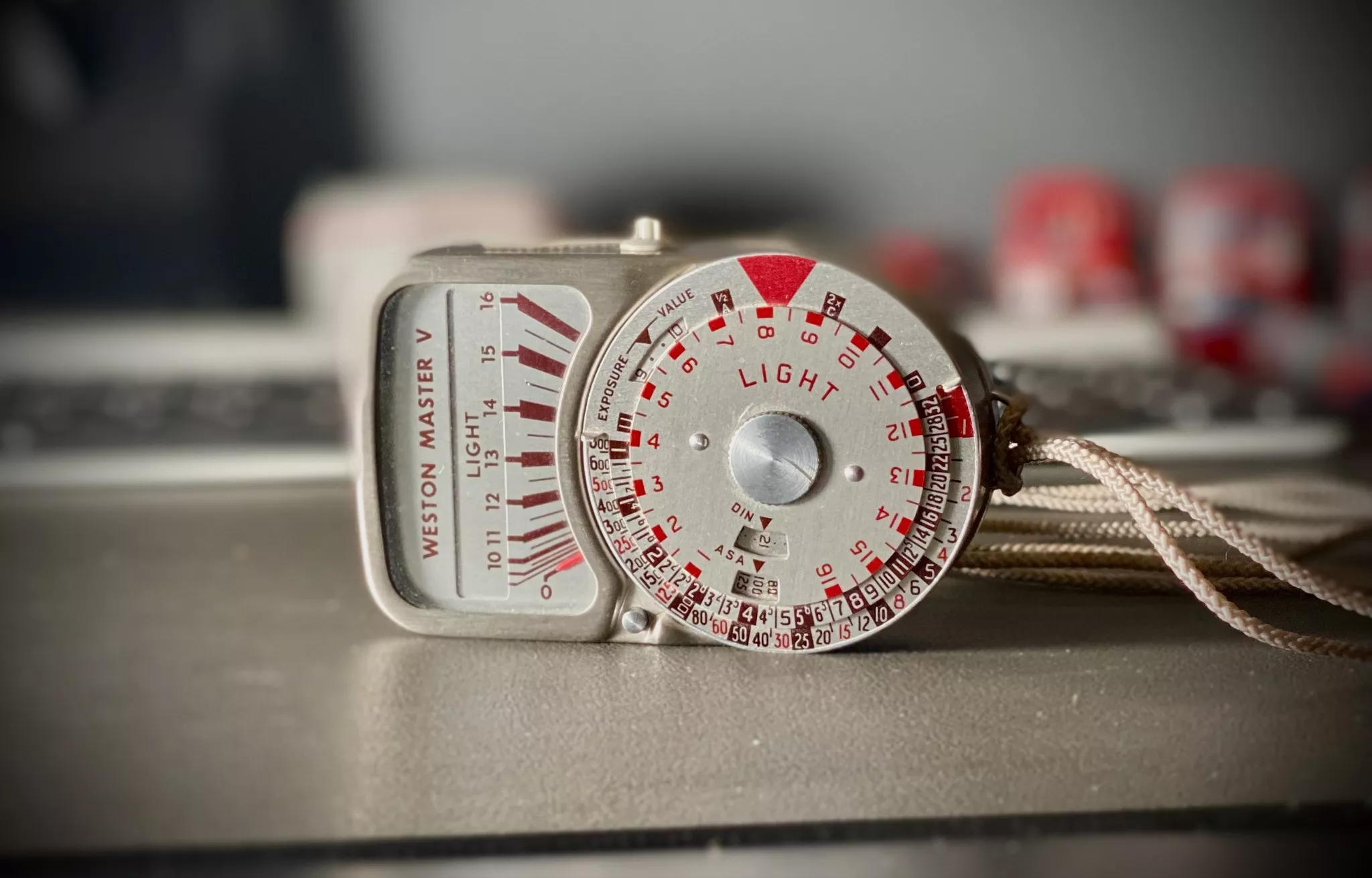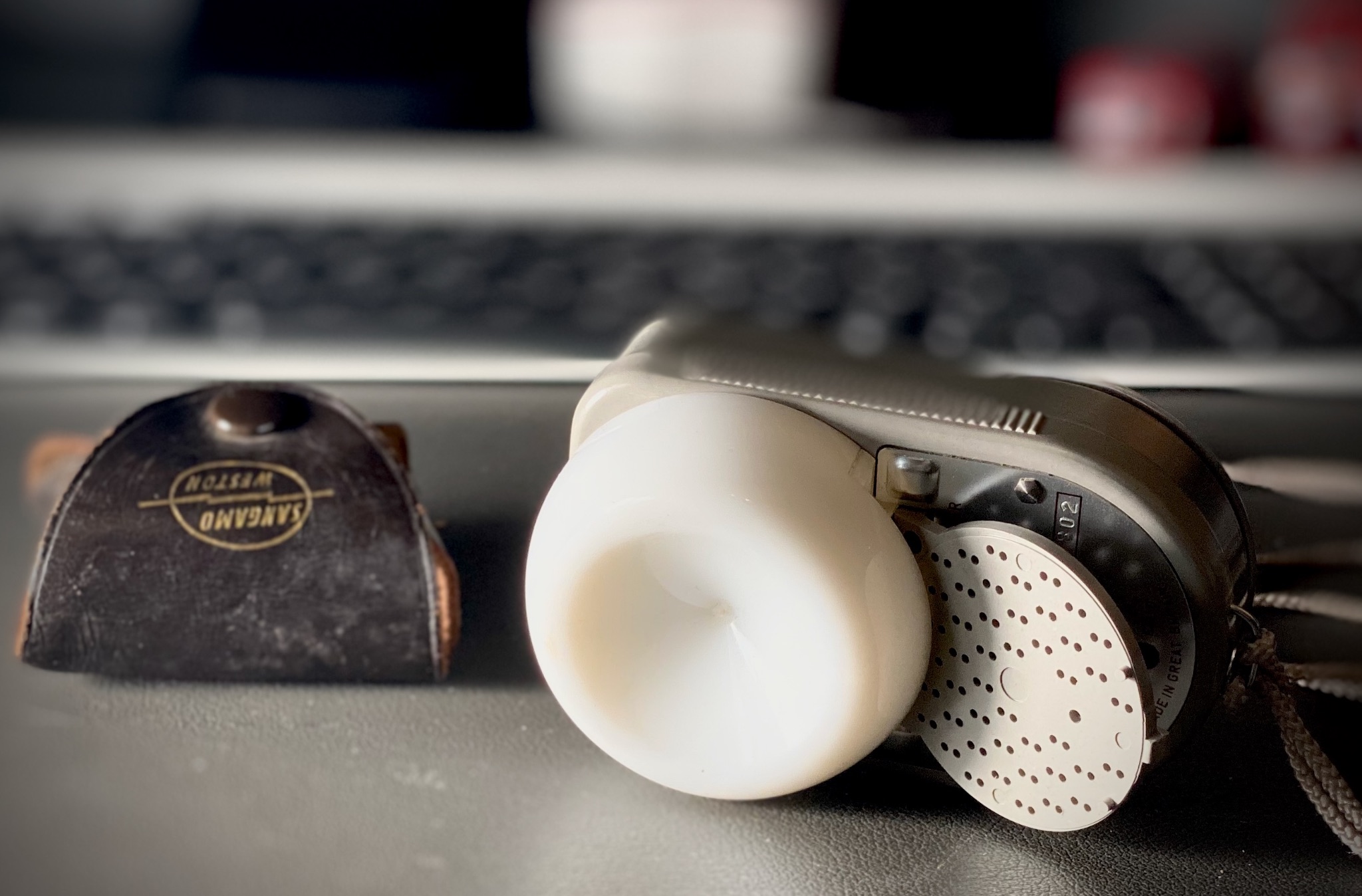I am a product of the film era, however, I never owned a light meter. I started in photography in 1983, by which time exposure meters had been built into mainstream SLRs for many years. Even my first camera, the Soviet Zenit 11, had a light meter in it, or rather, I should say on it. The Zenit’s light meter was a selenium cell strip placed below the pentaprism, where these days the company brand name would be seen.
That selenium cell leads me nicely to the subject of today’s article, the Weston Master V light meter.
Whilst SLRs of the 70s and 80s had built-in TTL metering, many medium-format cameras did not. The exposure for them was determined using a hand held meter, such as those from Weston. They used the same selenium cell technology as my Soviet Zenit, although, I suspect, with more finesse and better engineering.
I inherited my Weston Master V from my late uncle. He was one of the reasons I am still into photography and at one time the proud owner of a Hasselblad 500C. To nail the exposure on his “Blad” he used the Weston.
So how do you use a 50-year-old light meter, and more importantly, how does it stack up against today’s modern, high-tech cameras?

The Story Of Weston
There is a good chance that many of you reading this, have not heard of Weston. Yet back in the 70s and 80s, their name, in photographic circles, was up there with Nikon, Canon, and Kodak. They were an iconic brand back in the day, revered by photographers for their beautiful engineering as much as their function.
Created by prolific engineer Edward Faraday Weston, the first meters were released in 1932. Weston often created their own film speed ratings for popular film brands, these sometimes differed from the standard ASA rating given by the film manufacturers.
The first Master light meter was the Master III released in 1956. The Master V is a direct descendant and was originally released in the early 70s. Like the earlier Westons it used a selenium cell to measure light levels. Let's take a look at how it works.

Getting To Grips With The Master V
Holding a Weston Master V in your hand for the first time, two things might strike you, First, how beautiful it looks, a proper piece of old-school engineering. Secondly, how complicated it looks: Small buttons, rotating dials, an indicating needle. However, as complicated as it looks, if you understand any modern camera and the basics of the exposure triangle, the Master V is actually quite simple to use.
Despite appearances, there are actually only two rotating dials. The inner dial sets the ASA (DIN – an obsolete German film speed rating. The outer dial, allows you to dial in the EV level that the meter gives you. You can read the light two ways, reflected or incident, more on that later.
To take the light reading you simply hold the meter up and press the large button. If the reading falls below EV 10, you need to open a baffle on the back, this lets more light through giving a more accurate reading in low light.

When you press the button, the meter needle will move. You read the EV value that the needle is pointing to and then rotate the outer dial so that the EV value lines up with the large red arrow. You then read off the required shutter speed and aperture from the outside of the dial and apply it to your camera. It’s that simple. But how accurate is it?
Reflected, Incident, and Accuracy
Modern meters in cameras are amazing. However, they can be fooled by tricky lighting. That’s because they use a reflected light reading. You point the camera towards the subject and the meter reads the light reflected from it.
Modern matrix meter systems use complex algorithms to determine the scene in front of them and compensate for the exposure. In general, they are very good at that but sometimes will get it wrong.
Older metering in early DSLRs and late SLRs was nowhere near as advanced and could easily fail. Here’s where Weston's party trick comes into play, incident light reading.
An incident light reading is where you measure the light directly falling on the subject rather than reflecting from it. That gives you a much more accurate reading in difficult lighting conditions. To do this on the Weston Master V, you have to place a special Invercone over the light cell, then walk up to your subject, point the light meter toward the camera, and take the reading.

In the examples below I have taken three shots. I deliberately chose the Angel of the North because it is a very dark subject with an often very bright sky. This is the perfect scenario for fooling meters.
The three shots, in order, are my Fujifilm XH2 using matrix metering in manual mode. The exact meter reading was applied to the shot. Secondly a reflected light reading using the Weston Master V and thirdly an incident light reading taken from the base of the statue.



As you can see, the matrix metering from the modern mirrorless camera and reflected reading from the Master V are very similar. Both exposed the scene overall, maintaining definition in the sky but at the expense of detail in the Angel.
The incident light reading, however, has exposed the light falling on the statue, not reflecting from it, and has given us a much better reading overall. Quite impressive for a 50-year-old meter using near 100-year-old technology.
So The Weston Master V Is Better Then?
Not really. You see, these days we don’t just have to rely on the meter to nail the exposure. We have LCD screens, we have algorithms and we have histograms. Modern cameras will nail most exposures, but if they don’t we can review them on screen or better still, check the exposure on the histogram. Reading a histogram is the modern equivalent of reading a meter.
But there is more, modern cameras have more dynamic range than even the best films. Even if we are one or two stops off with our exposure, we can often pull the image back to get a good result.
So as beautiful as the Weston Master V is, it really doesn’t have any advantages over modern cameras. That said, I use my medium format Fujifilm GFX 50s much like a medium format film camera. I can see plenty of times when I might take the Weston along with me, for nostalgia's sake and maybe, just maybe to keep some old traditions alive.





1 Comment
Interesting article, thank you!
I’ve had a Master V since the 1970s but unfortunately its selenium cell has become insensitive. However I’ve inherited another Master V which is perfect so I’m happy, and use it quite a bit in my film photography.
May I comment on your observation that “modern cameras have more dynamic range than even the best films.” I would argue that it depends on what kind of film is being used. Exposure for reversal film certainly has to be nailed spot on, however negative films, both colour and monochrome, have a very wide latitude and are extremely tolerant of quite a degree of over-exporsure.
The rule for negative film is to expose to the right, i.e. if there’s any doubt about the correct exposure, always over expose – this will ensure a good exposure and a printable negative. By contrast, the rule with digital is always to expose to the left, i.e. never risk overexposure since the highlights will burn out and be unrecoverable, better to under-expose if there’s any doubt.
The webpage below is useful because it shows the difference between the two media and I think the conclusion is that both have a similar dynamic range, but in different directions from the optimum.
https://petapixel.com/2019/05/02/film-vs-digital-this-is-how-dynamic-range-compares/